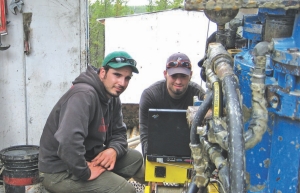The Phoenix uranium discovery by Denison Mines (DML-T, DNN-A) is one of the most promising new uranium discoveries to come out of Saskatchewan’s Athabasca basin in the last 20 years. It joins a short list of recent major discoveries that includes Hathor Exploration’s (HAT-V) Roughrider deposit and Cameco’s (CCO-T, CCJ-N) Millennium deposit.
With grades rivalling McArthur River and Cigar Lake, two of the richest uranium deposits in the world, but at a much smaller size, Phoenix is estimated to hold 35.6 million lbs. uranium oxide in an indicated resource of 89,900 tonnes grading 17.99% U3O8. An additional 3.8 million lbs. U3O8 hosted in 23,800 tonnes of 7.27% U3O8 are inferred.
Denison made the Phoenix discovery in the summer of 2008 while drilling the Wheeler property. Discovery hole 249 intersected 1.72% U3O8 across 1.4 metres, at a depth of 408 metres. During a follow-up winter drilling campaign in 2009, the potential high-grade nature of this new discovery was shown by hole 258, which cut 2.3 metres of 18.7% U3O8 at 397 metres downhole.
The Wheeler property is 35 km southwest of the McArthur River uranium mine in northern Saskatchewan. The road from the Mc- Arthur River mine to the Key Lake mill, as well as the power line to the mine, cuts through the 120-sq.-km property. Wheeler is owned 60% by Denison, 30% by Cameco and 10% by JCU Canada Exploration. Denison is the operator.
Since announcing the Phoenix discovery hole, Denison has completed 106 core holes totaling 50,000 metres. It has encountered two distinct zones of high-grade uranium mineralization, zones A and B, at the unconformity contact between the Athabasca Group sandstones and underlying lower Proterozoic Wollaston Group metasedimentary rocks. Mineralization and alteration have been traced over a strike of nearly 1.3 km to date.
During this summer’s exploration program, which comprised 20,300 metres in 43 holes, Denison discovered two new mineralized zones, C and D, at the extreme southwest and northeast edges of the Phoenix trend.
A hole drilled at the southern most end of the Phoenix trend hit a new zone of mineralization, dubbed zone C, at 374 metres depth. Hole 328 cut 0.8 metre of 9.65% U3O8.
At the northeast end, a deep zone of strongly altered graphitic pelite was encountered in hole 325 beneath the much larger silicified sandstone cap. The graphitic zone contained elevated uranium values over a 66-metre-long intercept and included three low-grade intersections. The company believes that where this graphitic pelite intersects the unconformity there is the potential for high-grade mineralization.
During the upcoming 2011 winter exploration program, Denison will further test the favourable graphitic horizon updip at the unconformity where no drilling has been done to date.
“Both these new zones are open along strike and the results confirm our belief that the Phoenix discovery has great potential,” said Denison’s president Ron Hochstein in a recent conference call.
This summer’s drill program also extended the overall strike length of both zones A and B, by 55 and 110 metres, respectively. Drilling to date indicates zone A is 306 metres in strike, 20-25 metres wide and averages a thickness of 5.4 metres. Zone B is 260 metres long, 15 metres wide and 3 metres thick.
A 200-metre-long gap between zones A and B was tested during the program. Drilling confirmed the area is mineralized but at a much lower grade.
All of the 35.6-million-lb. indicated resource is contained in zone A, while the 3.8-million-lb. inferred resource is in zone B. Drill spacing across the deposits varies from 12.5 metres to more than 50 metres.
Denison believes the Phoenix discovery is a major deposit containing at least four discrete zones of mineralization. “To date, we have only explored 1.3 km of the 18-km trend,” said Hochstein.
A concept study is currently scheduled for completion in the fourth quarter. “It’s purely a concept study, it’s not a scoping study or a preliminary economic assessment,” explained Hochstein. “We will have some very rough capital and operating cost numbers, but probably the more important part of the concept study is firming up the schedule to move the project forward.”
For 2011, the Wheeler joint venture has planned a $10-million exploration campaign that will comprise a 70-hole drill program, which will be the largest program carried out to date on the property.
Denison reported revenue of US$39.9 million for the third quarter and US$89.1 million for the year to date. This resulted in a net loss of US$9.5 million, or US3¢ per share, for the three months, and a loss of US$1.9 million, or US1¢ per share, for the nine months.
Cash flow from operations was US$14.1 million for the quarter and US$28.5 million for the nine-month period. As of the end of the quarter, Denison had a cash balance of US$33.1 million and a working capital of US$78 million.
Denison produced 373,000 lbs. U3O8 and 1 million lbs. V2O5 during the third quarter. Uranium sales for the three-month period totaled 706,000 lbs. U3O8 at an average price of US$44.22 per lb., down from US$54.82 per lb. for the same period a year ago. According to Jim Anderson, Denison’s chief financial officer, the lower price is a reflection of a stagnant spot price over the summer months.
Uranium spot prices have risen over the past month from the mid-forties to US$53.50 per lb.
“What is different though about this rise in price, as opposed to other rises we have seen in the last couple of years, is it is not driven purely by supply shortages but is driven more so by increased demand,” said Hochstein. “It is our opinion that a new level in the low fifties will be sustained into 2011.”


Be the first to comment on "Denison’s enticing Phoenix discovery"